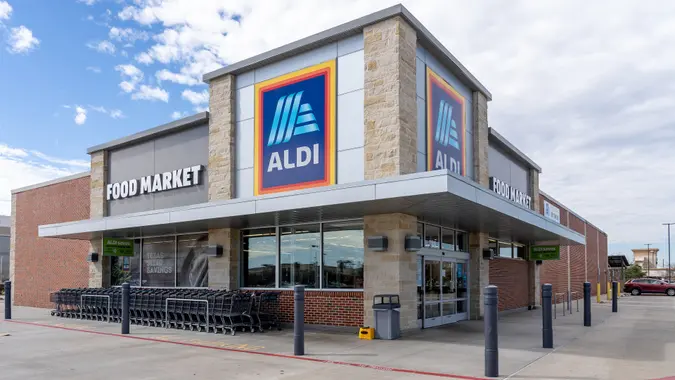Here’s The Most You Should Be Spending on Groceries. Where Do You Fall?

Commitment to Our Readers
GOBankingRates' editorial team is committed to bringing you unbiased reviews and information. We use data-driven methodologies to evaluate financial products and services - our reviews and ratings are not influenced by advertisers. You can read more about our editorial guidelines and our products and services review methodology.

20 Years
Helping You Live Richer

Reviewed
by Experts

Trusted by
Millions of Readers
Do you feel like your grocery bill is taking a disproportionate bite out of your paycheck? You’re not alone. A recent study by BadCredit.org found that many Americans use more than half of their pay to buy food.
For many people, especially those earning minimum wage, working more than twenty hours a week just to afford food leaves little room in the budget for other necessary expenses.
How Much ‘Should’ You Spend on Groceries
Financial experts suggest that you only spend four to six times your hourly wage on groceries. Therefore, if you make $15 an hour, your grocery budget “should” be between $60 and $90 each week. However, with rising food costs, spending just $240 to $360 for food each month is pretty much impossible.
Your hourly wage’s purchase potential depends on where you live, the minimum and median wages in that area, and the cost of living (and therefore the cost of food) there. The best place to buy groceries, for both minimum-wage and median-wage earners, is the District of Columbia. However, workers in D.C. must still spend over eight hours of work each week to afford groceries. That is double the standard budget recommendation, showing how impossible that old standard is to reach nowadays.
Food Prices Hit Minimum-Wage Workers Hardest
If you’re making minimum wage, putting food on the table can be a real challenge. The federal minimum wage has stagnated at $7.25 since 2009, while grocery prices have shot up by about 47%.
In Mississippi, for example, workers have to spend over 65% of their weekly paycheck just to buy groceries. That means they might need to work 26 hours a week just to afford food, leaving little room for anything else.
Other states, like North Carolina, Georgia, Louisiana, and South Carolina also require between 22 to 27 hours of minimum-wage income per week to afford groceries. That’s more than half of a paycheck just for food, which leaves little left for rent and other necessities.
On the brighter side, states like Washington and Oregon have higher minimum wages, which means workers there can spend much less of their income on groceries — sometimes just 10 hours a week. Northeastern states like Maine, Vermont, and Rhode Island also clock in at between 8 and 10 hours per week of minimum-wage work to afford groceries. This gives residents in these states a bit more breathing room for other expenses.
Middle-Class Families Also Struggle
It’s not just minimum-wage earners who feel the pinch. Many middle-income families also struggle with grocery costs. In expensive states like California and Massachusetts, grocery bills can take up to 30% of a median-income worker’s paycheck. Even in places with a lower cost of living, like New Hampshire and Minnesota, families may still spend about 6 to 7 hours of their week just working to afford groceries.
However, there are several states where median-income earners can follow the financial guideline of spending four to six times their hourly wage on groceries. These locations match higher median incomes with lower costs of living and include places like Washington D.C., Minnesota, New Hampshire, Wisconsin, and Maine. This budgeting doesn’t account for any luxury spending though, and is still very much a bare-minimum guideline.
Simple Tips To Cut Grocery Costs
If you’re feeling the squeeze at the grocery store, don’t worry. There are plenty of ways to save money without sacrificing the quality of your meals.
Plan Your Meals
Take some time each week to plan your meals. By knowing what you need to buy, you can stick to a shopping list, shop less often, and avoid impulse buys that add up quickly.
Buy in Bulk
Stocking up on non-perishable items like rice, pasta, and canned goods can save you money in the long run. Buy one or two extra when they’re on sale to stretch your budget further.
Use Coupons and Cashback Apps
Look for coupons in newspapers or online, and consider using cashback apps to earn money back on your grocery purchases. Most grocery stores have loyalty programs that offer discounts too.
Shop Seasonal and Local
Buying fruits and vegetables that are in season can be cheaper and fresher than exotic, out-of-season veggies. Check out local farmer’s markets for great deals and to support your community.
Look For Community Help
If you’re struggling to afford food on top of your other basic expenses, check out community resources like your local food bank or food pantry. These resources exist to make sure that people in tough financial straits don’t go hungry, and they are excellent for supplementing a limited food budget.
More From GOBankingRates
 Written by
Written by  Edited by
Edited by 

























